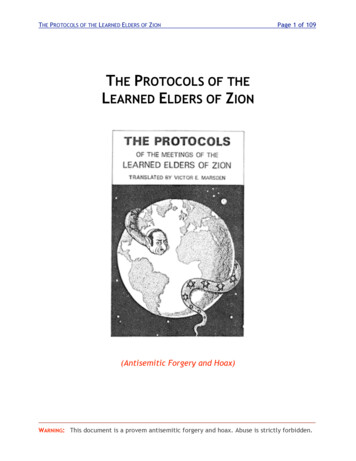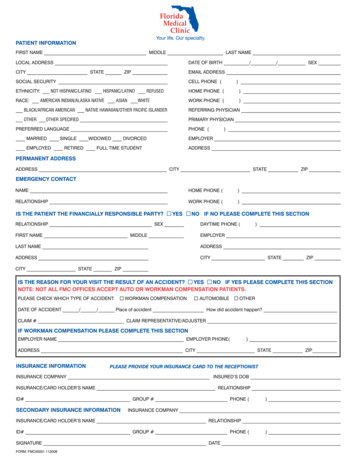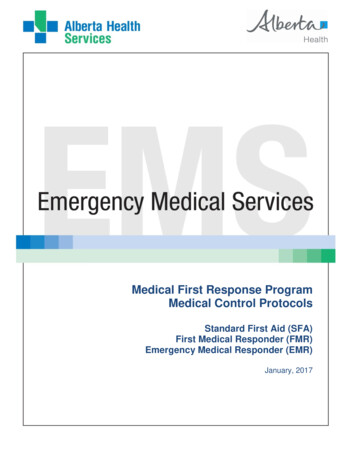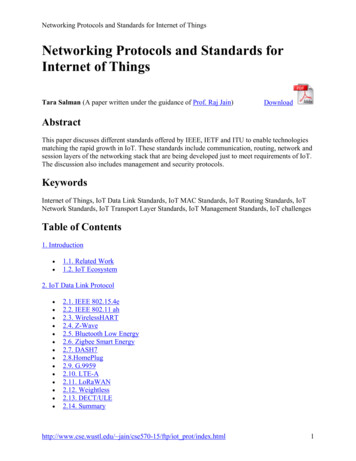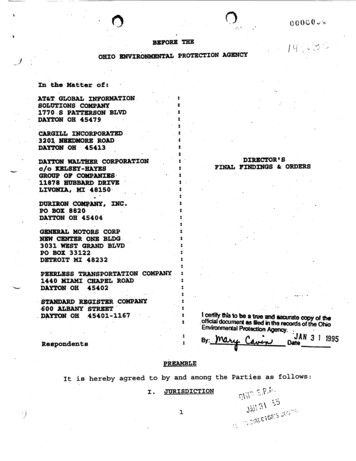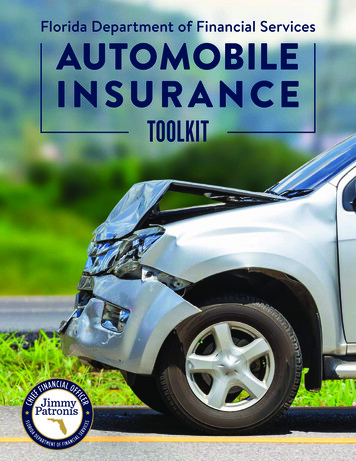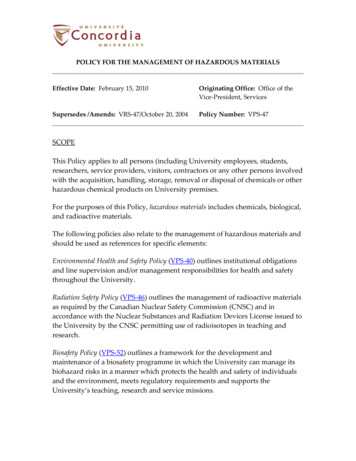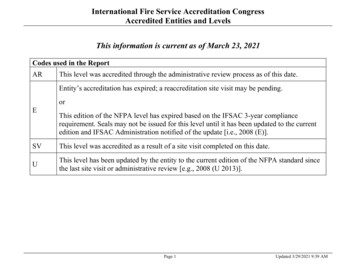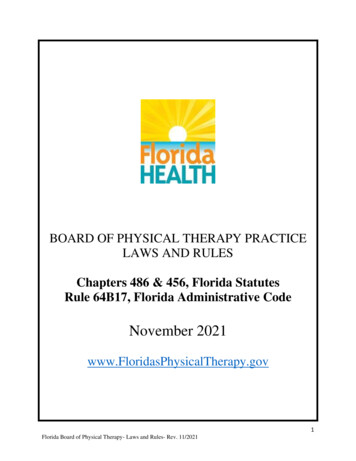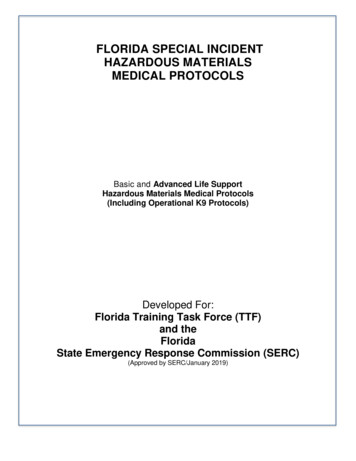
Transcription
FLORIDA SPECIAL INCIDENTHAZARDOUS MATERIALSMEDICAL PROTOCOLSBasic and Advanced Life SupportHazardous Materials Medical Protocols(Including Operational K9 Protocols)Developed For:Florida Training Task Force (TTF)and theFloridaState Emergency Response Commission (SERC)(Approved by SERC/January 2019)Protocols approved by SERC/January 2019/RHS/ASB1
Florida Special Incident Hazardous Materials Medical Protocols.Basic and Advanced Life Support Hazardous Materials Medical Protocols(Including Operational K9 Protocols)Developed through the East Central Florida Local Emergency Planning CommitteeAuthored by:Armando “Toby” BevelacquaRichard “Rick” StilpThese protocols could not be possible without the assistance from these professionalsin the field of toxicology, veterinarian medicine, and emergency response. Theseprotocols went through detailed review by the following professionals.HazMat Medic ReviewRobert Cruthis, Paramedic, Seminole County Fire DepartmentButch Loudermilk, Paramedic Lieutenant, Seminole County Fire DepartmentJacksonville Poison ControlJay L. Schauben, PharmD, DABAT, FAACT, schauben@poison.ufl.eduDawn Sollee, PharmD, DABAT, FAACTThomas Kunisaki, MD, FACEP, ACMTMiami Poison ControlJeffery N. Bernstein MD, FACEP, FACMT, FAACT, DABCP, J.Bernstein@med.miami.eduRichard S. Weisman, Pharm.D., FAACT RWeisman@med.miami.eduTampa Poison ControlDr. Fred Aleguas aaleguas@tgh.orgVeterinarian ReviewKristin Wolfenden D.V.MVeterinary Medical over-site Orange County Sheriff Office, Orlando, FLLee Palmer, DVM, MS, DACVECC, NRP, EMT-T, WEMT, CCRP, TP-CLieutenant Colonel, US Army Reserve, Veterinary CorpsLisa A. Murphy, VMD, DABTAssociate Professor of Toxicology, University of Pennsylvania, School of Veterinary MedicineThanks to Tom O’Connel for your review and input of the Radiation segment of theseprotocols.Protocols approved by SERC/January 2019/RHS/ASB2
INTRODUCTIONThese Hazardous Materials Protocols are developed to guide EMS Personnel in the treatmentof victims exposed to dangerous chemicals and environmental conditions specific to hazardousmaterials response. They are comprehensive in nature and are intended to be used by localmedical directors in the development of protocols that are customized for each individualarea/jurisdiction. Although, these protocols can be adopted in whole, it is typical for a committeeworking with their local medical control, to fine tune this document into a more customizedprotocol for their community.Although true hazardous material incidents do not happen every day, what is seen on a frequentbases are the personal misuse of chemicals both in the household and in the workplace settingcausing exposures. These are typically not classified as a hazardous materials incident. In fact,most of the patient exposures that are treated by emergency responders do not come from adispatched hazardous materials incident. Instead the emergency response was dispatched assome kind of general medical call and it was not until the EMS providers arrived and found thatan exposure was responsible for the resulting symptoms.There are sections in this protocol dedicated to our canine (K9) emergency responders. Since2001, the use of K9s by the military, law enforcement, and US&R has increased significantly.The increased use of these K9s to find accelerant and explosives compounds, live humans,human remains, drugs, and more is mostly related to increased efforts in improving domesticsecurity. Over the past decade the skills of these K9s has increased allowing them to be utilizedby even more specialized units. In many cases these K9s are dispatched to search and findpeople or hazards in damaged, dangerous, and sometimes contaminated areas. Unfortunately,at times, these Operational K9s (OpK9s) have become victims themselves. Frequently therehave been questions, especially from the K9 handlers, regarding the use of the human hazmatmedical protocols for their K9 partners. Understandably, a lot of funding, effort, and love hasbeen put into these valuable K9 partners so efforts should be made to preserve their health andwell-being. It was for this reason that K9 protocols have been placed into this SOP. Of note, itis understood that before any paramedic implements these protocols, they must have alreadyreceived appropriate training in K9 first aid care from a licensed veterinarian. Establishing aworking relationship with a veterinarian to develop training and to approve specific protocols isa necessary step if your agency plans to institute any of these K9 protocols.This is a comprehensive guide towards the treatment of hazardous substance exposure withsupportive treatments and modalities. It does not include any typical EMS BLS/ALS typeprotocol. Those should be consulted when this SOP refers the user to their own local EMSprotocols.Although these protocols are backed by research and practical application, they do encompassinvasive advanced life support skills. Any and all application of invasive skills/treatments mustbe approved and sanctioned by the physician serving as your agency’s medical control.Protocols approved by SERC/January 2019/RHS/ASB3
RESPONSIBILITYIt is the responsibility of all individuals involved in this type of response to take precautions toavoid primary exposure and reduce the occurrence of secondary exposure while, at the sametime, rendering appropriate medical care. Responders who are specifically trained in hazardousmaterials (hazmat) medical response are defined as follows:EMS/HazMat Operational ResponderA Basic Life Support trained provider certified at either a State or National level as an EmergencyMedical Technician (EMT) and has successfully completed a hazmat operations level corecurriculum (as identified in NFPA 472, 2017 edition), preferably with the mission specificcompetencies of Decontamination and Personal Protective Equipment.ToxmedicAn Advanced Life Support (ALS) provider certified at either a State or National level as aParamedic and has successfully completed a hazmat Operations level core identified in NFPA472, 2017 edition, and a HazMat Medical course that identifies Toxidromes (toxic syndromes)with specific treatment modalities found in NFPA 473, 2017 edition. Mission specificcompetencies at a minimum and should include decontamination and personal protectiveequipment.HazMat MedicAn Advanced Life Support (ALS) provider certified at either a State or National level as aParamedic and has completed the mandatory coursework and is recognized as a HazmatTechnician as identified in NFPA 472, 2017 edition. In addition, the paramedic has completed aHazMat Medical course that identifies Toxidromes (toxic syndromes) with specific treatmentmodalities found in NFPA 473, 2017 edition. Mission specific competencies at a minimum andshould include decontamination and personal protective equipment.OpK9 (Operational K9) HazMat MedicA HazMat Medic with the added interest and training in the protection and care of workingOpK9s. In addition, the Medic has facilitated a relationship with both the OpK9s he/she isresponsible for and developed an understanding and written protocols through a veterinarianproviding oversight.Working OpK9A Law Enforcement, US&R, or other force protection or search and rescue agency K9 that hasbeen trained for a specific task such as human search and rescue, locating live human or humanremains, explosive accelerant or narcotic detection, etc. An Operational K9 Unit – is a OpK9 withits human handler.Color Coding – To assist in both organization and physical use, these protocols includecolor coding that can be used for quick reference and for color coding the HazMat DrugBox. The color-coding system used in this document first appeared in 1987 with theinstitution of the first hazmat medic program within the Orlando Fire Department.Protocols approved by SERC/January 2019/RHS/ASB4
TABLE OF CONTENTSIntroduction ty --------------------------------------Table of Contents --------------------------------Situational Assessment -------------------------HazMat Alert -----------------------------Safe Patient Approach/Evaluation -Toxidrome Exam ----------------------------------3456666Gateway Protocols --------------------HazMat Toxidromes (HZT) -----------710Corrosives and Irritants – HZT01 stems: Skin, Eyes, and Respiratory System ----------------------Chlorine, Chloramine, Ammonia, and Phosgene ------------------Hydrofluoric Acid and Fluorine Based Chemicals ----------------Phenol (Carbolic Acid) ----Lacrimator --------------------Asphyxiant – HZT02 ---------------Simple Asphyxiants --------Chemical Asphyxiants ---Carbon Monoxide -Cyanide and Hydrogen Sulfide ---------------------------------Methemoglobin Generators --------------------------------------Cholinergic – HZT03 (Green) ------Hydrocarbons and Derivatives – HZT04 (Brown) -----------------------------Toxic Alcohols ----------------Etiologic – HZT05 (Black) -----------Radiological – HZT06 (Yellow) ed Protocols (AP) -----------50Closed Space Fires – AP01 (Orange) ing Secondary to Toxic Inhalation – AP02 (Lavender) ------------Tachycardia Secondary to Chemical Exposure – AP03 (Dark Green) -Hypotension Caused by Exposure – AP04 (Light Purple) ----------------Seizures Post Exposure – AP05 (Turquoise) ----------------------------------Opioids Overdose/Exposure – AP06 (Light Grey) ---------------------------Heat and Hyperthermia – AP07 (Light Blue) -----------------------------------Cold Related Injuries – AP08 (Dark Grey) 586065Procedures (P) ---------------------------66P1 – Pre-Entry Medical Evaluation -P2 – Post-Entry Medical Evaluation/Rehabilitation -------------------------------P3 – CPAP --------------------------------P4 – Eye Irrigation Lens System ----P5 – Capnography -----------------------6668707273Policies and Additional Guidance -74HazMat Alert ------------------------------Medical Control --------------------------Poison Control Centers ----------------On-Call Canine Veterinary Services Recommended Drug, Formularies, and Equipment ocols approved by SERC/January 2019/RHS/ASB5
SITUATIONAL ASSESSMENTHAZMAT ALERTIn conjunction with these protocols it is recommend that your EMS service enact a policy called“HazMat Alert”. HazMat Alert is used to provide early notification to the hospital that they arereceiving a patient who has been injured by a chemical. In addition, a notification is made to theRegional Poison Center. Not so different than a “STEMI Alert”, or a “Trauma Alert” the HazMatAlert allows the hospital to prepare for a patient who may need additional specialized medicalcare providers, an isolation room, or may need to mobilize specialized equipment includingadditional decontamination equipment. The Alert should provide the hospital with key datapoints such as the number of patients involved, the overall signs and symptoms, the possiblechemical involved, and any treatment provided. The Regional Poison Center can rapidly deploypre-packaged toxic substance/antidotal therapy fact sheets through its emergencycommunication systems to the receiving medical facility or to multiple health care facilities, ifneeded. A sample HazMat Alert policy can be found under the policy section of this document.SAFE PATIENT APPROACHBecause this manual focuses on human (and K9) exposures to toxic materials we would beremised to not talk about scene safety and personal protective equipment (PPE). Although thisdocument reviews in depth assessment and treatment, it will not get into definitive scene safety,selection of PPE, and Decon unless it is related to treatment. It is expected that the scene ismade safe and appropriate steps have been taken to keep the responders safe from initial andsecondary exposure. Following the Gateway Protocol for Patient Approach/Evaluation on everypatient involved in an exposure to a hazardous material will help to keep the responder safeduring a response.TOXIDROME EXAMThe toxidrome exam is different than a trauma or typical medical exam. Instead the hazmatmedic is looking for specific, and sometimes subtle, signs and symptoms displayed fromchemical exposures. Overall Assessmento Vital signs including temperature, Masimo/Rainbow to assess Carboxyhemoglobin andMethemoglobin levels.Eyeso Pupil size, reaction to light, Corneal color (haziness), Epithelial exam (sloughing), Circulation (intactin sclera).Mucous Membraneso Color and MoistureRespiratory Statuso Rate, Lung Sounds, Capnography, Oximetry.Cardiac Statuso Heart Rate, EKG to evaluate critical rhythms and QRS (sodium channel blockers) such as ST andPR interval widening (Slowed repolarization), Ectopy.Skino Color, Moisture, Temperature, Burns, IrritationMusculoskeletalo Tremors and/or rigidity, hyperreflexia, fasciculationMental Statuso Confused, Obtunded, Aggressive, AlertGeneralProtocols approved by SERC/January 2019/RHS/ASB6
GATEWAY PROTOCOL – INITIAL PROTOCOLoOdors presentIn these protocols it is assumed that the patient has been made safe for treatment. This mayinclude removing the patient from the scene of the exposure, removing contaminated clothing,and decontamination. In addition, it is assumed that the EMS care provider is wearingappropriate Personal Protective Equipment (PPE).At any point when decontamination is identified in the protocol it is highlighted to ensurethe procedure was accomplished or there are special circumstances for the procedure.Note: It is never appropriate to perform any ALS skills in the Hot Zone. Rapid rescue anddecontamination is recommended prior to starting any ALS procedures.Patient Approach/Evaluation:o Approach the scene with caution.o Ensure that the patient has been removed from the Hot Zone.o Be aware of potential contamination hazards in both the terrain and on objects.o The patient's clinical presentation and location may offer clues about the type of HAZMATsubstance. (Situational Assessment Continuum [SAC])o Don appropriate PPE.o Ensure that the patient is safe to assess, treat, and transport.o Monitor for respiratory compromise, cardiovascular abnormalities, shock, or other lifethreatening conditions (simple vital signs).o If in respiratory distress or arrest follow the local Emergency Airway Procedure.o Consider secondary system contamination (i.e. eye exposure may also cause arespiratory exposure)o Low concentrations may take time to manifest or present signs and symptoms. (Conductthe toxidrome exam).o High concentrations may have an immediate affect and, in addition, have latent symptomsappearing much later. These factors are dependent on the chemical, route of entry, andthe target organ involved.o Follow the appropriate and specific HAZMAT Toxidrome protocols if appropriate.K9 Patient:o Maintain team safety by ensuring, when feasible, that the K9 handler is alwaysinvolved when approaching and handling an injured K9.o K9 Handling and Restraint: Consider applying a muzzle prior to handling a conscious K9 when nocontraindications to muzzling exist (e.g. upper airway obstruction,respiratory complications, severe facial trauma, heat-related injuries,vomiting, comatose, etc.) Any injured or stressed K9 is considered unpredictable and may bite, evenits own handler.OpK9 HazMat Medics should always carry a quick application type muzzlein a known easily accessible location for expedient use when and if needed.It is strongly urged to have at least two alternate team members trainedon basic K9 handling techniques for situations when the handler is down.When feasible, these personnel should have a well-established and positiverapport with OpK9s they support.Protocols approved by SERC/January 2019/RHS/ASB7
Assessment/TreatmentBasic Life Support Assess respiratory status and secure a patent airway. Take vital signs and record pulse oximetry prior to placing the patient on oxygen.o Provide supplemental oxygen at 100% via non-rebreather mask.o Auscultate lung sounds and assess oxygenation status.o If breathing is slow, suppressed, or absent secure an airway and supportventilations. Obtain vital signs and complete a head to toe survey of the body surface area. Avoid all body fluids/substances. Obtain history of exposure.o Method/route of exposure (skin/eye exposure, respiratory, ingestion, penetratinginjury).o Specific chemical involved.o Time of exposure.o Duration of exposure.o Substance or activity involved in the exposure.o Symptoms specific or those that occurred after the exposure.o Past medical history including preexisting medical conditions and currentmedications. If there is a known chemical exposure, contact Poison Control for additional guidance.(See “Policies and Further Guidance. III. “Poison Control Centers”Advanced Life Support Provide advanced airway management as needed Begin advanced assessmento Monitor Pulse oximetry (Normal 96%-99% SaO2). Both before and after oxygenadministration.o Monitor Capnography (Normal 35-45 mmHg)o Monitor Carboxyhemoglobin (Normal 0.85-4%). Take action ifcarboxyhemoglobin above 10%.o Monitor Methemoglobin (Normal 1-3%). Take action if above 15% or if symptomsare seen or 10% in patients with a previous history of anemia, heart disease, orvascular disease.o Watch for rebound bradycardia (High BP with slow HR)o Cardiac monitoring including 12 lead EKG if warranted (cardiac irritability, EKGchanges such as prolonged ST interval or widened QRS complex) Treat any abnormalities in respirations and blood pressure per your local protocol. Provide advanced treatment as identified in the Toxidrome Protocols includingspecialized medications and antidotes. Contact receiving hospital and Regional Poison Control Center and provide HazMatAlert.Protocols approved by SERC/January 2019/RHS/ASB8
PediatricPediatric patients breathe faster and have higher metabolisms. Both of these factors canproduce more acute severe effects after an exposure. Keep in mind that a moderate exposureto an adult can be severe and life threatening to a pediatric patient.Note: In this protocol, specific pediatric doses are identified when they are different froman adult’s. Children over 100 pounds or 50 Kg are considered to be of an adult size andreceive an adult dose unless the dosage is calculated in mg/Kg. In some cases, age isnoted to determine appropriate dosage.K9 Patient:Depending on the type of exposure a K9 can develop symptoms quicker than their humancounterparts exposed to the same toxins. In some cases, K9s actually tolerate exposures betterand display fewer symptoms than humans. Initial assessment should immediately includemonitoring the respiratory and cardiovascular status then supporting both of these. Followtoxidrome specific K9 protocols once the exposure has been identified.Protocols approved by SERC/January 2019/RHS/ASB9
TOXIDROMESCORROSIVES AND IRRITANTS – HZT01CDESCRIPTION:Corrosives and irritants are a group of chemicals that have the ability to cause inflammation orburns (of various degrees) to tissues. This can include eyes, skin, and/or respiratory system.These chemicals can be classified as highly water soluble, moderately water soluble, or primarilylipid soluble. They can also be classified as having a high pH (alkali) or a low pH (acid).Depending on these characteristics the damage suffered to the exposed tissue is predictableallowing treatment to begin even before many of the symptoms present themselves.Patient Approach/Evaluation: Follow Gateway Protocol on the initial patient approach/evaluation.SYSTEM EXPOSURE, CORROSIVES ANDIRRITANTS Eyes Skin RespiratoryEyesEye exposure to a corrosive/irritant chemical is a true emergency. Irrigation should not bedelayed for any reason with the exception of immediate lifesaving efforts. Delay in initial irrigationmay result in loss visual acuity, total loss of vision, or loss of globe. Immediate irrigation can beaccomplished quickly from almost any water source (tap water, saline, sterile water, etc.)Assessment/Treatment:Basic Life Support (Adult and Child) A rapid assessment of the eyes to determine the severity of the injury.oSloughing of the epithelial tissue (Mild Injury)oMild signs Cloudiness of the cornea (Moderate Injury)oMild and Moderate signs Opaque cornea (Severe Injury)oMild and Moderate signs Porcelainization (completely white w/o blood vessels)of the sclera (Severe Injury) Immediately start eye irrigation by whatever means possible.Note: A nasal cannula can be used on the bridge of the nose as an apparatus to irrigateboth eyes but, the eyes lids may have to be held open to facilitate adequate irrigation.Protocols approved by SERC/January 2019/RHS/ASB10
Insure all particulate matter or contact lenses are out of the eyes by digitally openingthe lids and pouring irrigation fluid across the globe.Contact the hospital and provide (Hazmat Alert) Advanced Life Support (Adult and patient 8 years old)o If not contraindicated, prepare the Eye Irrigation Lens by attaching an IV solutionof normal saline, insure that fluid continues to flow at steady rate.o Apply 2 drops of Tetracaine ophthalmic drops into each of the eyes. (In most casesboth eyes are involved.) Before applying Tetracaine determine if the patient isallergic to “caine” derivatives.oInsert the lens and secure the tubing.oAdjust the flow so that a continuous solution is flowing from the eye.oContinue irrigation until arrival at the emergency department.oAfter 15-20 minutes of irrigation consider reapplication of ophthalmic drops to keepthe patient comfortable during irrigation. Start IV of 1000cc Normal Saline at a KVO rate. Strongly consider sedation to reduce anxiety:oDiazepam (Valium) 2 – 10 mg IV/IO oroMidazolam (Versed) 2.5 mg IV/IO (systolic must be greater than 90 mmHg) (1.5mg for elderly, debilitated or patients with other CNS depression) oroLorazepam (Ativan) 2 mg IM/IV/IO and can be repeated after 5-10 minutesPediatric Considerations (eye exposure)Adult Gateway Eye Protocols are applicable to pediatric patients. Do not use Morgan lenses in patients less than 8 years old. The use of ophthalmic drops is appropriate to relieve pain and discomfort in pediatricpatients. Do not sedate pediatric patients.K9 Patient (eyes) Consider all the above without the use of the Eye Irrigation LensThe use of Tetracaine ophthalmic drops is appropriate and safe for K9s.Consider sedation to reduce injury to the K9 and personnel providing treatment: Refer toK9 anesthetic / analgesic protocol in appendix.SkinSkin exposure are the most reported chemical injury in the U.S. pH and solubility must be takeninto consideration when assessing the extent of the injury and developing a treatment strategy.Assessment/Treatment:Basic Life Support Ensure decontamination has occurred or is underway.oImmediately provide continuous irrigation of the exposure site by whatever meanspossible.oDepending on the solubility of the chemical an emulsifier may need to be used toremove the substance. (mild detergent, olive oil, mineral oil)Protocols approved by SERC/January 2019/RHS/ASB11
Assess the body surface area affected. For large burns use the rule of nines to assesspercentage of skin involvement.Assess vital signs, oxygenation, and end tidal CO2 (Capnography).Contact the hospital and Poison Control Center and provide (Hazmat Alert)Advanced Life Support In any irritant/corrosive injury always assess for secondary respiratory exposure. Provide advanced monitoring including oximetry, capnography, and Masimo/Rainbow. Once the chemical is known, access specific Toxidrome Protocols for further treatmentoptions.Pediatric Considerations (Skin Exposure)All Adult Gateway Skin Protocols are applicable to pediatric patients.K9 Patient (Skin)General Concepts: Skin pH:o Human: more Acidic – 5.2 to 6.2o K9: more Alkaline – 5.5 to 8.0 Low pH Human Shampoos/soapso Human-based shampoos tend to be more acidic (pH 7)o May have adverse effects on the K9 skin High pH (.8) Soaps / Detergentso Safer for K9 eyes and skin; however, may compromise effectivenesso Most dish soaps (e.g. Dawn ) have neutral pH (7-8).Basic Life Support (K9) Wear appropriate PPE to avoid secondary contamination. Remove contaminated outerwear (collars, clothing, harness, vest, other). Decontaminate the affected area with a neutral pH detergent / soap and water,making sure you don’t spread the chemicals in the fur to other areas. If necessary to assess and treat the burned tissue, use clippers or scissors to cut hairfrom the area. If the chemical burn is in the mouth, lie the dog on his side and pour cool waterthrough the mouth a cupful at a time or use a garden hose for a constant, coolflow. Once decontaminated, cover the burned skin with a non-adherent, sterile (orclean) bandage. Contact veterinarian services for further guidance. (See Policies and FurtherGuidance section IV, “On-Call K9 Veterinarian Services)Advanced Life Support Support respirations. Maintain hydration and perfusion with IV 0.9% Sodium Chloride (Normal Saline). Maintain body temperature (Normal 100-102.5o F (37.7 – 39.2o C).Protocols approved by SERC/January 2019/RHS/ASB12
RespiratoryWhen an inhaled irritant/corrosive chemical is water soluble the upper airways are generallyaffected causing burns and irritation to those areas. These injuries produce wheezing andrhonchi upon auscultation. If the chemical is highly water soluble the resulting injury may occurabove the vocal cords and produce stridor. When the chemical is more lipid soluble, the lowerairways/alveoli are affected producing rales upon auscultation. Surfactant found in the alveoli islipid soluble and is easily disrupted by chemicals that reach the alveoli. Injury to the alveolicauses chemically induced (non-cardiogenic) pulmonary edema. Loss of surfactant causesatelectasis. Both of these conditions are treated with Continuous Positive Airway Pressure(CPAP).Note: In all cases the lungs may sound wet and rhonchorous as abundant production ofsecretions follow the airway irritation.Assessment/Treatment:Basic Life Support Ensure the patient is in a safe environment and, if needed, decontamination has occurred. Assess overall respiratory status:o Lung soundso Oximetry (obtain before and after supplemental oxygen is given)o Capnography Give 100 % Oxygen by NRB If the chemical is water soluble, provide a nebulizer (updraft) of saline to dilute the chemicalin the airways.Advanced Life Support Provide advanced airway if needed. If wheezing is noted on auscultation:o Initiate a nebulized updraft of either Albuterol (Proventil or Ventolin) and/or IpratropiumBromide (Atrovent). Albuterol 2.5mg (0.5mL of 0.5% diluted to 3mL with sterile normal saline) give vianebulizer. May be repeated 3 times. Ipratropium Bromide 0.5mg (500 mcg)/2.5 ml via nebulizer repeat at 20 minuteintervals for a total of 3 doses (usually only one dose given in the field).o Administer methylprednisolone (Solu-Medrol) 125 mg, IVP slowly. Monitor heart rate. Contact medical control if HR over 150 bpm.o Consider the administration of Brethine/Terbutaline Subcutaneous Injection. Brethine (Terbutaline sulfate) 0.25 mg given subcutaneous injection. (0.25ml of a1mg/ml solution) Especially if a rapid heartrate is a concern.oRepeated in 15-30 minutes if no improvement.o Maintain adequate ventilation and oxygenation Assess: Oximetry Capnography EKGProtocols approved by SERC/January 2019/RHS/ASB13
Provide CPAP and set the PEEP setting at or above 10 cm of H2O and 100% Oxygen.(or select the high setting) Provide advanced airway if needed. Control seizures or anxiety with Valium or Versedo Diazepam (Valium) 2 – 10 mg IV/IO oro Midazolam (Versed) 2 – 2.5 mg IV/IO (Max 10 mg) oro Lorazepam (Ativan) 2 mg IM/IV/IO and can be repeated after 5-10 minutes Consult specific Toxidrome Protocols for additional medical treatment guidance.Contact receiving hospital and the Poison Control Center and provide HazMat Alert.Pediatric Considerations (Respiratory Exposure)Pediatric patients may show more severe symptoms because they will receive a higher dose ofa chemical if in the same environment as adult victims. Pediatric patients breathe andmetabolize faster.Note: Administration of a nebulized Inhalation Solution is not recommended
should include decontamination and personal protective equipment. OpK9 (Operational K9) HazMat Medic A HazMat Medic with the added interest and training in the protection and care of working OpK9s. In addition, the Medic has
